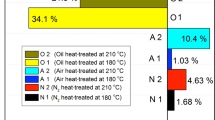Abstract
The effects of thermomechanical refining pressures, varying from 2 to 18 bars, on the cell-wall properties of refined wood fibers of a 54-year-old loblolly pine (Pinus taeda L.) with reference to both juvenile (JW) and mature wood (MW) were investigated using nanoindentation and atomic force microscopy. The results of this study indicate that refining pressure plays a significant role in the physical damage sustained by refined wood fibers. No obvious damage was observed in the cell walls of MW fibers refined at 2 and 4 bar. Nanocracks (<500 nm in width) were found in fibers refined at pressures in the range of 2–12 bar for JW and 6–12 bar for MW, and micro cracks (>3,000 nm in width) were found in both MW and JW fibers subjected to a refining pressure of 14 and 18 bar. The micro damage to the fibers refined at higher pressures was more severe inside the lumen than on the surface of the fibers, and the lumen or S3 layer was significantly damaged. The elastic modulus, hardness, and creep resistance of MW fibers were higher than those of the JW fibers subjected to the same refining-pressure conditions. The elastic modulus and hardness decreased, whereas nanoindentation creep increased, with increasing refining pressure. This study also suggests that lower refining pressures (<4 bar) and higher pressures (>14 bar for MW and >12 bar for JW) should be avoided in the manufacture of fiberboards and wood fiber–polymer composites, because of the lower aspect ratio of the fiber bundles, shorter length of the fibers and fines, and severe damages to the fiber cell walls.








Similar content being viewed by others
References
Clemons C (2002) Wood–plastic composites in the United States, the interfacing of two industries. For Prod J 52(6):10–18
Fischer-Cripps CA (2002) Nanoindentation. Springer, New York, p 197
Gindl W, Gupta HS, Schöberl T et al (2004) Mechanical properties of spruce wood cell walls by nanoindentation. Appl Phys A 79:2069–2073
Groom LH, So CL, Elder T, Pesacreta, T, Rials TG (2006) Effects of refiner pressure on the properties of individual wood fibers. In: Characterization of the cellulosic cell wall, Chap 17. Blackwell, Oxford, pp 227–240
Kelley SS, Elder T, Groom LH (2005) Changes in the chemical composition and spectroscopy of loblolly pine medium density fiberboard furnish as a function of age and refining pressure. Wood Fiber Sci 37:14–22
Krug D, Kehr E (2001) Influence of high pulping pressures on permanent swelling-tempered medium density fiberboard. Holz Roh-Werkst 59:342–343
Lee S, Wang S, Pharr G, Xu H (2007a) Evaluation of interphase property in a cellulose fiber-reinforced polypropylene composite by nanoindentation and finite element analysis. Compo A Appl Sci Manuf 38:1517–1524
Lee S, Wang S, Pharr G, Kant M, Penumadu D (2007b) Mechanical properties and creep behaviour of lyocell fibers by nanoindentation and nano-tensile testing. Holzforschung 61(3):254–260
Maloney TM (1986) Juvenile wood—problems in composition board products. In: Proc. of Juvenile wood: what does it mean to forest management and forest products? Forest Prod. Res. Soc., Madison, WI, pp 72–74
Neimsuwan T, Wang S, Ye XP (2008) Effects of refining steam pressure on the properties of loblolly pine (Pinus taeda L.) fibers. Holzforschung 62:556–561
Oliver WC, Pharr GM (1992) An improved technique for determining hardness and elastic modulus using load and displacement sensing indentation experiments. J Mater Res 7:1564–1583
Saucier JR, Cubbage FW (1990) In: Proceedings of southern plantation wood quality workshop. Southeastern Forest Experiment Station, Asheville, 95 p
Snell R, Groom LH, Rials T (2001) Characterizing the surface roughness of thermomechanical pulp fibers with atomic force microscopy. Holzforschung 55:511–520
Suchsland O, Woodson GE (1990) Fiberboard manufacturing practice in the United States. Forest Products Research Society, USA, pp 59–178
Tze WTY, Wang S, Rials TG, Pharr GM, Kelley SS (2007) Nanoindentation of wood cell walls: continuous stiffness and hardness measurements. Compo A Appl Sci Manuf 38:945–953
Wimmer R, Lucas BN, Tsui TY, Oliver WC (1997) Longitudinal hardness and Young’s modulus of spruce tracheid secondary walls using nanoindentation technique. Wood Sci Technol 31:131–141
Xing C, Zhang SY, Deng J, Riedl B, Cloutier A (2006) Medium-density fiberboard performance as affected by wood fiber acidity, bulk density, and size distribution. Wood Sci Technol 40:637–646
Xing C, Wang S, Pharr G et al (2007) Effect of refining on nano-mechanical properties of MDF fibers. Abstract in: biographies and abstracts. Forest Products Society 61st international convention, Knoxville, TN, 10–13 Jun 2007, p 15
Xing C, Wang S, Pharr G, Groom L (2008) Effect of thermo-mechanical refining pressure on the properties of wood fibers as measured by nanoindentation and atomic force microscopy. Holzforschung 62:230–236
Acknowledgments
The authors wish to thank Dr. John Dunlap and Dr. Seung-Hwan Lee for their kind help in preparing the specimens. We gratefully acknowledge Dr. Les Groom at the Southern Research Station, Forest Service of USDA, for providing the fiber samples. The National Research Initiative of the USDA Cooperative State Research, Education and Extension Service, grant number # 2005-02645, the Tennessee Agricultural Experiment Station (Project TEN 00MS-96), and the USDA Wood Utilization Research Grant supported the project. Instrumentation for the nanoindentation work was provided through the SHaRE Program at the Oak Ridge National Laboratory, which was sponsored by the Division of Materials Science and Engineering, U.S. Department of Energy, under contract DE-AC05-000R22725 with UT-Battelle, LLC.
Author information
Authors and Affiliations
Corresponding author
Rights and permissions
About this article
Cite this article
Xing, C., Wang, S. & Pharr, G.M. Nanoindentation of juvenile and mature loblolly pine (Pinus taeda L.) wood fibers as affected by thermomechanical refining pressure. Wood Sci Technol 43, 615–625 (2009). https://doi.org/10.1007/s00226-009-0266-1
Received:
Published:
Issue Date:
DOI: https://doi.org/10.1007/s00226-009-0266-1




